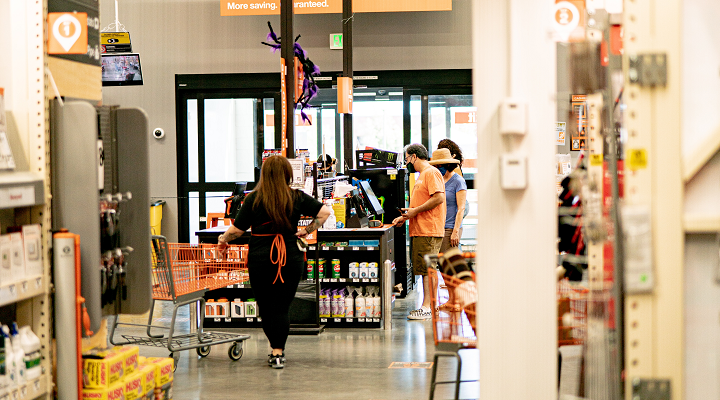The retail media industry is growing at a rate that businesses are struggling to keep up with. According to market research company eMarketer, US retail media ad spend will reach $70 billion (US$45.15 billion) this year, an almost 20 per cent increase compared to 2022. By 2027, it is predicted that retail media ad spend will account for more than a quarter of all US digital ad spend, reaching $164 billion (US$106.12 billion). In such a rapidly expanding market, it’s important to take a look
look at which companies are taking the time and energy to invest in retail media innovations.
Home Depot is leading the charge
When it comes to retail media, one of the companies leading the way with its in-store and online media offerings is The Home Depot.
According to a July 2023 report from marketing analytics platform Improvado, Home Depot is ranked as having the fourth largest retail media network in the US, after Amazon Advertising, Walmart Connect, and Roundel (Target’s retail media network), with over 183 million average monthly unique visitors.
Inside Retail sat down with Melanie Babcock, Home Depot’s vice president of Retail Media+ and monetisation, to discuss how the home improvement retailer set up its Retail Media+ program and how it has expanded its retail media offerings since the initial launch in 2018.
“The initial idea was to allow our suppliers to buy retargeting ads to drive traffic back to the website and back to their pages for conversion,” Babcock said.
“I partnered very closely with the Facebook team, now Meta, and we created a portal to allow our suppliers to identify that they did have traffic that was abandoning their product information pages or their carts, to then be able to spend money to target them [consumers] to come back and to convert.”
Developing an in-store network
At the same time this was happening, she explained, Home Depot was also working on on-site retail media capabilities.
“When we initially entered into the retail media space, we had a few core products that were focused heavily on our website. Those were banner advertisements and in-grid sponsored search ads. We have since grown pretty significantly in our owned properties, bringing our mobile app and email properties into the fold,” Babcock said.
“Our biggest area of growth is our stores. We have 100 stores that will be online in the next six months with a variety of screens that will deliver advertising through what we call our in-store network and we will continue to scale that.”
As of July 2023, Home Depot’s in-store network is in 50 locations.
Not surprisingly, Home Depot has found that in-store displays help drive sales. According to the brand, when consumers engage with products being advertised through Retail Media+, they spend 10 per cent more time on Home Depot’s website, are 26 per cent more likely to convert, and 28 per cent of consumers spend more money per visit.
Exploring new partnership opportunities
Another area the brand is planning to shift its retail media focus to is with outside advertisers.
“We are looking for ways to expand with CTV [connected TV] partners, whether it’s Paramount or Hulu, which is a Disney property, or Roku, because we are seeing a lot of interest in doing more brand advertising with our suppliers but they want to use a Home Depot audience to target.”
Home Depot has also launched a Pro site, focusing on contractors who shop at the retail business and created an influencer program, further diversifying its network.
Future of retail media
When it comes to what to expect next from the retail media industry, Babcock wants to see the greater regulation of measurement and reporting of consumer data.
“I think there needs to be a lot of standardisation [within the retail media industry] and that’s not a super sexy idea,” she chuckled. “Standardisation in terms of reporting and definition of terms like incremental sales. I hear that a lot from our suppliers, especially the ones that participate in multiple retail media networks. ‘How do I know what you are saying is the same as [an alternative retail media network] over here?’ A lot of companies want to invest in retail media, they just don’t know which retail media networks are the best for them. Standardisation is going to help out and that starts with measurement.”
Another shift Babcock wants to see across the retail media industry is the way in which retailers use it to help extend the customer experience – and that means focusing on in-store networks.
“I also think that we haven’t really tapped into the store. For the majority of retailers, not e-commerce, but physical retailers like us, our biggest sales converting moment is in the store. Our website is highly successful and we’d be lost without it, but at the same time, the store does attract the majority of the footsteps. What are we doing in the store to extend the customer experience and help the customer make decisions?” she said.
“We need to think about what is our opportunity to extend the customer experience in-store through retail media. I think there’s a lot of innovation yet to come in that space.”

